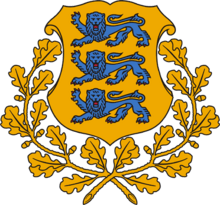Mu isamaa, mu õnn ja rõõm facts for kids
"Mu isamaa, mu õnn ja rõõm" is the national anthem of Estonia. Its name means 'My Fatherland, My Happiness and Joy'. Estonia first chose this song as its anthem in 1920.
The song has a long history, starting in the 1800s. An Estonian poet named Johann Voldemar Jannsen wrote the words (lyrics) in 1869. The music was created by Fredrik Pacius in 1848. Interestingly, this same tune is also used for Finland's national anthem, "Maamme".
When the Soviet Union took control of Estonia in 1940, this anthem was not allowed. Four years later, Estonia became part of the Soviet Union. A different song became the official anthem for the region. In May 1990, just before the Soviet Union ended, Estonia became independent again. The country quickly brought back "Mu isamaa, mu õnn ja rõõm" as its national anthem.
Contents
Lyrics of the Estonian Anthem
The national anthem of Estonia has three verses. Each verse expresses love and pride for the country. Below are the original Estonian words and their English translation.
Estonian Words
|
Original Estonian
|
|
Mu isamaa, mu õnn ja rõõm, |
English Translation
Here is a poetic translation of the Estonian anthem. It helps people understand the meaning of the words.
- My native land, my joy – delight,
- How fair thou art — how bright!
- For nowhere in the world around
- Can ever such a place be found
- So well belov'd, from sense profound,
- My native country dear!
- My tiny crib stood on thy soil,
- Whose blessings eased my toil.
- May my last breath be thanks to thee,
- For true to death I'll ever be,
- O worthy, most belov'd and fine,
- Thou, dearest country mine!
- May God in Heaven thee defend,
- My own beloved land!
- May He be guard, may He be shield,
- For ever bless and guardian wield
- Protection for all deeds of thine,
- My own, my dearest land!
Interesting Facts
- This anthem shares its melody with "Maamme", the national anthem of Finland. This shows a special connection between the two countries.
See also
 In Spanish: Mu isamaa, mu õnn ja rõõm para niños
In Spanish: Mu isamaa, mu õnn ja rõõm para niños


